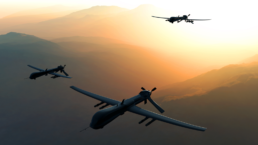The new project, as announced to a confab of defense industry executives yesterday, was no doubt music to their ears.
By Kelley Beaucar Vlahos, Responsible Statecraft
What better place than a National Defense Industrial Association confab to announce a new program in which “multiple thousands” of drones will be unleashed across land, sea, and sky “to counter the PLA’s [People’s Liberation Army’s] mass with mass of our own, but ours will be harder to plan for, harder to hit and harder to beat.”

It rings a bit like science fiction but to a roomful of defense executives, Deputy Secretary of Defense Kathleen Hicks’ words on Monday must have been music to their ears. A lot of dollar signs. Especially when Adm. John Aquilino, head of U.S. Indo-Pacific Command, joined in and told the NDIA “Emerging Technologies for Defense” audience that there could be as many 1,000 drones deployed in 24 hours — “Here’s a metric for me: 1,000 targets for 24 hours.”
At which point Hicks signaled that might be just the baseline. “We’ll also aim to replicate and inculcate how we will achieve that goal, so we can scale whatever’s relevant in the future again and again and again. Easier said than done? You bet. But we’re going to do it,” she said.
Welcome to the second era of the drone war, the first being during the U.S. Global War on Terror, where drones like the MQ Reaper were primarily used for surveillance and manhunting. It was billed as an “evolution” in targeted conflict in which the government promised “cleaner” war with fewer civilian deaths and American boots on the ground. Today’s era is about “meshing” both surveillance and lethal action with a pronouncement of drones, all shapes and sizes, and not just the big expensive ones. This is being tested and improved everyday with tens of thousands of drones on both sides in Ukraine and now the Pentagon is promising the next level of that for its coming war with China.
Recent Posts
The Rage Of Billionaires And The Frenzy To Stop Zohran Mamdani From Becoming New York’s Mayor
June 30, 2025
Take Action Now The constellation of forces now regrouping with a vengeance includes titans of Wall Street, enormous real estate interests,…
It’s Not Just The Cities. Extreme Heat Is A Growing Threat To Rural America.
June 28, 2025
Take Action Now The urban heat island sits in a rural heat ocean.By Umair Irfan, Vox Summer has officially begun with a blast of scorching…
Mamdani’s Massive Victory Should Show Democrats Where The Party’s Future Lies
June 27, 2025
Take Action Now NYC mayoral candidate Zohran Mamdani has thrown the drowning Democratic Party a life vest. Will its leaders use it?By Sam…
India Walton’s Advice For Zohran Mamdani
June 26, 2025
Take Action Now “I think that for him, the race ’til November needs to be staying on message—we can’t start to water it down…




